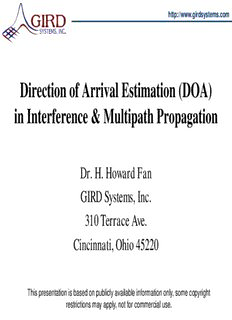
Direction of Arrival Estimation (DOA) in Interference & Multipath PDF
Preview Direction of Arrival Estimation (DOA) in Interference & Multipath
http://www.girdsystems.com Direction of Arrival Estimation (DOA) in Interference & Multipath Propagation Dr. H. Howard Fan GIRD Systems, Inc. 310 Terrace Ave. Cincinnati, Ohio 45220 This presentation is based on publicly available information only, some copyright restrictions may apply, not for commercial use. http://www.girdsystems.com Scope • There are many location methods Source location vs. Self-location (Navigation) Active vs. Passive Network based (GPS) vs. Single platform (DOA or AOA) • We will concentrate on source location with a single platform equipped with a sensor array, passive • Emphasis on DOA estimation • Narrowband signals only http://www.girdsystems.com Outline • Basics of DOA Estimation Beamforming Type High Resolution Type • Adaptive Beamforming DOA Estimation in Strong Interference • High Resolution DOA Estimation in Multipath • Smoothing Method • Source Association and Locating the Sources http://www.girdsystems.com Outline • Basics of DOA Estimation Beamforming Type High Resolution Type • Adaptive Beamforming DOA Estimation in Strong Interference • High Resolution DOA Estimation in Multipath Smoothing Methods • Source Association and Locating the Sources http://www.girdsystems.com Objective of DOA Estimation • To find DOA (relative to the array orientation) of all incident RF rays • Could have multipath propagation and interference DOA Est / Tracking http://www.girdsystems.com Narrowband Signal Sources • A complex sinusoid j jt jt s(t) e e e • A real sinusoid is a sum of two sinusoids j jt j jt jt jt cos(t ) e e e e e e 1 2 2 2 • A delay of a sinusoid is a phase shift jt jt jt s(t t ) e e e s(t) 0 0 0 • Apply approximately to narrowband signals http://www.girdsystems.com A Uniform Linear Array A signal source s(t) ejt 0 “impinges” on the array with an angle 0 c: propagation speed • If the received signal at sensor 1 is x (t) s(t) 1 (i 1)d sin • Then it is delayed at sensor i by 0 i c • Then the received signal at sensor i is (i1)dsin j 0 j j x (t) e x (t) e s(t) e c s(t) i i i 1 http://www.girdsystems.com Outline • Basics of DOA Estimation Beamforming Type High Resolution Type • Adaptive Beamforming DOA Estimation in Strong Interference • High Resolution DOA Estimation in Multipath Smoothing Methods • Source Association and Locating the Sources http://www.girdsystems.com Beamforming • Delay-and-sum type • Reverse the delay/phase on each sensor to “line-up” the received signal phase • Adding all phase-shifted sensor outputs to enhance the received SNR in that direction http://www.girdsystems.com Beamforming • By adjusting the delay or phase shifts, we electronically steer the beam through all look directions to find DOA of an incident signal • Received signal at the ith sensor: (i1)dsin j 0 j j x (t) e x (t) e s(t) e c s(t) i i i 1 • is the incidence angle of the received signal 0 • The delay or phase shift of the beamformer on the ith sensor is computed according to a “look angle” to get the output: (i1)dsin N N j * y(t) w x (t) e c x (t) i i i i1 i1 (i1)d[sinsin ] N 0 j e c s(t) i1
Description: